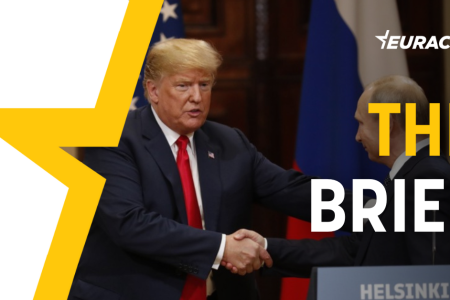Donald Trump promised a quick resolution to the war in Ukraine. If he succeeds, the most likely outcome is a ceasefire based on the current front lines remaining in place. This means, however, another frozen conflict, rather than peace.
Does Trump know that frozen conflicts are a Russian speciality? And does he know the reasons why Russia engineers such scenarios?
Assuming he does not, here is what he should know.
In the context of post-Soviet international relations, a frozen conflict is where active armed conflict has been brought to an end, but no peace treaty or other political framework is in place to resolve it.
The main reason why Russia engineers frozen conflicts is to prevent post-Soviet countries it borders from getting close to the EU and NATO.
As a rule, the EU and NATO require an applicant country to solve territorial disputes with its neighbours before it joins. (A huge exception was made for Cyprus, which joined the EU in 2004 while not controlling almost half of its territory, now considered EU territory, despite being under the orders of Ankara.)
Russia likes to make sure that several independent post-Soviet states have sovereignty over the entirety of their territory in name only. In reality, Russian puppets still control large swathes of their country.
Over the years, this has been the case with Nagorno-Karabakh, an Armenian enclave in Azerbaijan’s territory, with Transnistria, a Russian-controlled enclave in Moldovan territory, South Ossetia and Abkhazia, two Russia-controlled territories that officially are part of Georgia, and the limited sovereignty of Ukraine over Donbas, as foreseen under the Minsk agreements.
The conflict in these areas can remain frozen for a long time and can be easily reignited.
The Nagorno-Karabakh conflict dates back to 1988 (under the Soviet Union) and escalated in 1990 following the dissolution of the Soviet empire. Two Karabakh wars were fought, and close to 40,000 people were estimated to have lost their lives.
In 2024, Nagorno-Karabakh was formally dissolved as Azerbaijan took control of the territory while the Armenian population fled.
This became possible mostly because Russia dropped its support for Armenia, and strengthened its relations with Azerbaijan, a much richer country with a more powerful army.
The Moldovan Declaration of Independence of 1991 clearly claims Moldovan sovereignty over the territory of Transnistria, which, however, was unilaterally proclaimed in September 1990 as a Soviet Republic separate from Moldova.
A war broke out in Transnistria between November 1990 and July 1992 between elements of the Russian 14th Army and pro-Moldovan forces, including Moldovan troops and police.
Deaths are estimated between 300 and 600. Since then, Transnistria has remained out of the control of Chisinau and is fully dependent on assistance from Moscow, although officially, Russia does not recognise the independence of Transnistria.
The eight-day war between Russia and Georgia in 2008 resulted in the latter losing control of two of its regions: Abkhazia and South Ossetia.
Since then, only Russia, Venezuela, Nicaragua, Nauru, and Syria regard them as independent.
Russia clearly calls the shots in both regions, while the importance of Abkhazia is growing in the context of the war in Ukraine.
Moscow is currently building a naval base in Abkhazia, where it brought its remaining military flotilla to protect it from Ukrainian attacks.
The latest, and more explicit example of what a Ukraine ceasefire could be, are the Minsk 1 and 2 agreements of 2014 and 2015. These sought to end fighting in the Donbas region between armed Russian separatist groups supported by Moscow and the Ukrainian army.
While fighting subsided following the agreement’s signing, it never completely ended, and the agreement’s provisions were never fully implemented, although (or maybe because) they suited the Russian interest.
A Pax Americana version of Donald Trump, which would freeze the frontline, would not solve the territorial issues. Ukraine and the EU will continue to consider the territories occupied by Russia, including Crimea, as Ukrainian.
Neither would it provide justice, with war crimes remaining unpunished, no reparations would be discussed, and no security guarantees would be provided unless the EU provided these on its own initiative.
No actual peace process will follow, and Russia will be able to unfreeze the conflict whenever it likes.
To sum up, before he shakes hands with Putin, Trump should realise his quick deal is unlikely to be any different from what we have seen before and clearly will not work – except in the interest of Russia, which likes to keep its options open in the long term.
[Edited by Alice Taylor-Braçe/Rajnish Singh]“}]]
We give you energy news and help invest in energy projects too, click here to learn more

